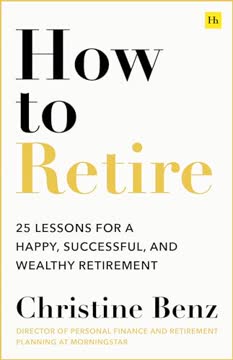Key Takeaways
1. Uncover and Rewrite Your Money Story to Build Confidence
Truly, whatever you’re feeling about money right now, you’ve got company.
Silence has costs. Many women avoid discussing money, preferring to talk about death than finances, often due to shame or feeling unknowledgeable. This silence leads to emotional and physical stress, missed opportunities for learning, and perpetuates structural financial challenges like the gender pay gap. The author's personal journey, despite a financial background, highlights how deeply ingrained negative money mindsets can be, stemming from childhood experiences and societal messages that women are "bad with money."
Childhood narratives. Our money stories are often formed in childhood, becoming hardwired, instinctive lenses through which we interpret financial matters. These early views can be disempowered and absolute, leading to adult feelings of incompetence, low self-esteem, and a diminished sense of self-worth, even for highly accomplished women. Recognizing that these outdated stories no longer serve us is the crucial first step toward financial wellness.
Rewrite your narrative. To transform your relationship with money, consciously uncover your current money story by asking: How do I feel about money? What does it represent? Where do these feelings come from? What beliefs have I formed? Then, rewrite it to reflect your adult strengths and potential. This process, supported by identifying internal resources, checking limiting language, and trying new motivational tools, builds hope and confidence, making you believe you are capable of change.
2. Align Your Money Relationships for Shared Financial Well-being
Money and finances are among the most common causes of friction in relationships.
Relationship stress. Money is a leading cause of conflict and divorce, with financial infidelity present in over 40% of relationships where finances are pooled. This tension often arises because couples combine finances without in-depth conversations about their money histories and values, leading to differing approaches to spending, saving, and planning. One partner frequently takes the lead, causing communication breakdowns and resentment for the less involved.
Hidden costs. Financial strain in relationships can lead to enormous stress during emergencies, reduce overall relationship satisfaction, and lower individual self-confidence and self-worth. Women, in particular, may feel disempowered when partners dismiss their financial understanding or when they put their own needs last. This dynamic prevents couples from being in sync, leaving them vulnerable to life's surprises and hindering personal financial growth.
Open communication. To foster financial harmony, reflect on your partner's money beliefs, understanding that their past informs their present, just like yours. Ensure both partners have equal access to all relevant financial accounts and information, even if finances are kept separate. Commit to regular money catch-ups—monthly or quarterly—to review spending, anticipated expenses, savings, and investments, splitting financial tasks to maintain engagement and mutual understanding.
3. Define Your "Why" to Fuel Your Financial Goals
Attaining lasting happiness requires that we enjoy the journey on our way toward a destination we deem valuable.
Daily demands. Modern life, especially for women, is often consumed by the "second shift" of unpaid labor, childcare, and carrying the mental load of family life. This constant busyness, coupled with financial unease stemming from the gender pay gap and wealth disparities, leaves little room for articulating long-term goals. Many women find themselves stuck in a "spin cycle," vaguely worrying about the future without a clear plan.
The power of purpose. Setting ambitious, heartfelt goals provides focus, direction, and motivation, transforming day-to-day financial actions from demoralizing tasks into steps toward a desired future. Behavioral psychology research shows that strong, internal motives for success lead to greater, more lasting achievement. Happiness, as positive psychology experts suggest, comes from the experience of climbing toward a valuable peak, not just reaching it.
Visualize your future. To uncover your "why," engage in visualization exercises:
- Ideal Future: Imagine yourself five to ten years from now, living your ideal life. Detail your surroundings, companions, and daily activities.
- Retirement Party: Reflect on what you would regret not having done, then flip those regrets into future aspirations.
- Perfect Ordinary Day: Describe a typical day you'd be happy to repeat, focusing on fulfilling, everyday moments rather than extravagant fantasies.
These detailed visions serve as powerful motivators, guiding your financial decisions.
4. Take a Clear Snapshot of Your Current Financial Reality
All it shows is where you stand today. And your net worth can be small—or even negative—for any number of reasons.
Financial fog. Many women reach midlife feeling financially insecure, living paycheck to paycheck, and lacking an emergency cushion, often due to structural issues like the gender pay gap and age discrimination. This unease, combined with an aversion to confronting financial realities, leads to avoidance. Ignoring finances, however, only perpetuates uncertainty and anxiety, making coherent financial planning impossible.
Self-compassion first. Before diving into the numbers, practice self-compassion. Many women harbor harsh inner critics, calling themselves "stupid" or "irresponsible" about money, which fuels avoidance. Reframe this task as "financial detective work"—simply gathering information without judgment to make thoughtful future choices. This shift in mindset is crucial for effective financial planning and reducing anxiety.
Two-part snapshot. To gain clarity, create two essential financial documents:
- Personal Balance Sheet (Net Worth Statement): List all assets (cash, investments, home value) and subtract all liabilities (mortgage, loans, credit card debt) to calculate your net worth. This number is merely a starting point, reflecting past investments or debts, not personal failure.
- Personal Income Statement (Income and Expenses): Track all monthly income and categorize all spending for a month. This reveals where your money is actually going, highlighting areas where spending aligns or misaligns with your values and goals.
5. Create a "Statement of Intent" (Budget) to Control Your Cash Flow
The truth is, rather than being a surefire path to self-deprivation, a budget, or a statement of intent, makes you the boss of your money, instead of the other way around.
Budget aversion. The word "budget" often evokes negative associations like deprivation or being "bad with money," especially for women who are frequently targeted by "overspending" narratives. This aversion leads many to avoid creating a financial plan, resulting in impulse purchases, persistent high-cost debt, insufficient emergency funds, and inadequate retirement savings. Without a budget, it's easy to remain stuck in a paycheck-to-paycheck cycle.
Empowering intentions. Reframe budgeting as a "statement of intent," a powerful tool that puts you in charge of your money. It allows you to consciously allocate funds according to your true values and priorities, rather than reacting to expenses. This proactive approach frees up mental space, reduces financial unease, and provides the certainty that your essentials are covered, fostering a sense of power and control over your financial future.
Six-step allocation. Create your statement of intent by systematically allocating your monthly income:
- Add up Income: Calculate all reliable monthly income sources.
- Cover Essentials: Allocate funds for non-negotiable costs like rent, utilities, and periodic essential expenses.
- Allocate to Core Saving: Prioritize building an emergency fund (3-6 months of expenses) and contributing to retirement accounts (401k/IRA).
- Plan Debt Paydown: Focus on high-interest debt (e.g., credit cards) after emergency savings, balancing with investment returns.
- Save for Other Goals: Dedicate funds for specific aspirations like a home down payment, college (e.g., 529 accounts), or travel.
- The Extras: Allocate remaining funds for discretionary spending.
Automating transfers for savings and debt payments is crucial for consistent progress.
6. Master Investing Basics to Grow Your Wealth for Retirement
If you want to make sure you do not outlive your money, you need to invest your savings so they can grow.
Beyond saving. Saving alone is insufficient for long-term financial security, especially with increasing lifespans and retirement costs. Investing your savings is essential to make your money work for you, leveraging the power of compounding to grow wealth over decades. Despite this, women often feel less confident in investing than in budgeting or saving, frequently ceding long-term financial decisions to partners.
Overcoming barriers. The world of investing can feel daunting due to unfamiliarity (less financial education for girls), off-putting jargon, and language that often feels "male." However, women tend to be successful investors, researching more carefully and trading less, which leads to lower transaction costs and well-thought-out plans. Understanding basic terms and concepts, as provided in the appendix, demystifies this world and empowers you to participate.
Power tools for growth. Harness two key principles for successful retirement investing:
- Time: Start as soon as possible to maximize compounding, where your investment gains earn returns themselves. The "Rule of 72" illustrates how quickly money can double.
- Steadiness: Focus on long-term goals, setting an investment plan that aligns with your risk tolerance and retirement date, then resist the urge to react to short-term market fluctuations.
Automating contributions to workplace plans (401k/403b) and individual retirement accounts (IRAs) leverages human inertia, making consistent saving effortless.
7. Strategically Invest for All Your Life's Aspirations
Investing now will help you amass the resources you need to put those goals in reach.
Beyond retirement. While retirement investing is crucial, strategically investing for other life goals—like buying a home, funding children's college, or leaving a legacy—is equally important. The challenge lies in balancing these competing priorities and navigating varied investment recommendations, often without clear, unbiased advice from an industry that can inadvertently make women feel unwelcome.
The cost of delay. Postponing investing for these goals means missing out on the powerful benefits of compounding, which significantly amplifies returns over time. Given that women often face a wealth gap due to lower earnings, investing sooner rather than later is critical to offset potential shortfalls and build self-sufficiency, especially as women are likely to outlive their spouses and may need long-term care.
Four-step investment plan. To invest for life goals using a taxable investment account:
- Create Your Timeline: Organize goals (e.g., home down payment, travel) on a timeline (short, medium, long-term) and allocate funds to "goal buckets."
- Consider Risk Tolerance: Match investment risk to your timeline—low risk for short-term (CDs, money market), moderate for medium-term (bond funds, some stocks), and higher for long-term (more stock funds).
- Consider Tax-Smart Investments: Be aware of tax implications (long-term vs. short-term capital gains, dividends, municipal bonds) and favor passive funds (index funds, ETFs) for lower fees and tax bills.
- Identify Tax-Smart Options: Utilize specific accounts like 529 plans for college savings (tax-free growth/withdrawals for education) or strategically donate appreciated securities or IRA distributions for charitable giving.
8. Integrate Your Financial Plan with Life's Zigs and Zags
The only thing predictable about life is its unpredictability, so it’s better to know in advance how you might best respond.
Navigating the journey. You've built a comprehensive financial toolkit, but life is full of unexpected "zigs and zags." Your financial plan needs to be flexible, allowing you to adjust and fine-tune decisions to support your core goals amidst life's surprises. This involves combining small, repeatable financial moves with bigger life choices, ensuring your money continues to work for you.
Strategic life changes. Consider how major life decisions can impact your financial plan:
- Midlife and Earlier: Increase stock investments (if comfortable with risk and time horizon) and focus on boosting income through raises or side gigs, maintaining your current lifestyle to maximize savings.
- Later-Career Years: Explore working past age 65 (even part-time) to allow savings to grow longer and last less time, and delay claiming Social Security benefits until age 70 for significantly higher monthly checks.
- Any Age: Implement large-scale spending cuts (downsizing, reducing cars, staycations) and re-evaluate financial support to adult children, prioritizing your own financial security.
Weighing trade-offs. Every big decision involves trade-offs between short-term sacrifices and long-term benefits. Whether it's a "Big Move" like radical spending cuts or a "Slow and Deliberate" approach, the key is to make choices with full awareness of the potential gains and emotional costs. This clarity and confidence empower you to make the best decisions for your overall well-being, stitching together a roadmap for living life on your own terms.
9. Empower Others by Continuing the Money Conversation
If you can take these steps with the girls and women you know, it will benefit you and them.
Breaking the silence. Equipped with newfound financial skills and confidence, you are uniquely positioned to empower other women and girls. Many parents, often unintentionally, fail to provide adequate financial education, particularly to girls, and schools frequently lack required personal finance coursework. This leaves young people, especially those from low-income backgrounds, ill-prepared for consequential financial decisions like college loans and credit cards.
Ripple effect. Sharing your knowledge helps end women's collective silence and anxiety around money, fostering a supportive community where women lift each other up. By teaching financial literacy to the next generation, you contribute to reducing economic inequality and creating lasting financial empowerment. Research even suggests that helping others makes you happier, creating a positive feedback loop for your own well-being.
Practical steps to share:
- Everyday Education, Early: Start with young children by teaching coin values, using allowances to discuss spending/saving/sharing, and leveraging holidays for money lessons.
- Education About Education: Engage teenagers in conversations about college costs, balancing family contributions with their own responsibility, and making financial decisions as a team.
- Teaching Credit Safety: Educate teens on using credit cards responsibly to build a positive credit history, emphasizing paying bills in full to avoid high interest.
- Woman to Woman: Initiate open conversations with friends and colleagues about salaries, savings, and financial challenges. This can provide valuable information and foster a sense of shared experience and mutual support.
Last updated:
Review Summary
You Are Worthy receives mostly positive reviews, with readers praising its accessible approach to financial management for women. Many appreciate the book's focus on changing mindsets about money, personal stories, and practical exercises. Reviewers found it helpful for addressing money anxieties and building confidence. Some readers particularly valued the advice on investing and financial literacy. A few criticisms mention the book being geared towards a specific audience or not engaging enough. Overall, readers recommend it as an empowering resource for women seeking financial knowledge and stability.
Similar Books







Download PDF
Download EPUB
.epub digital book format is ideal for reading ebooks on phones, tablets, and e-readers.




